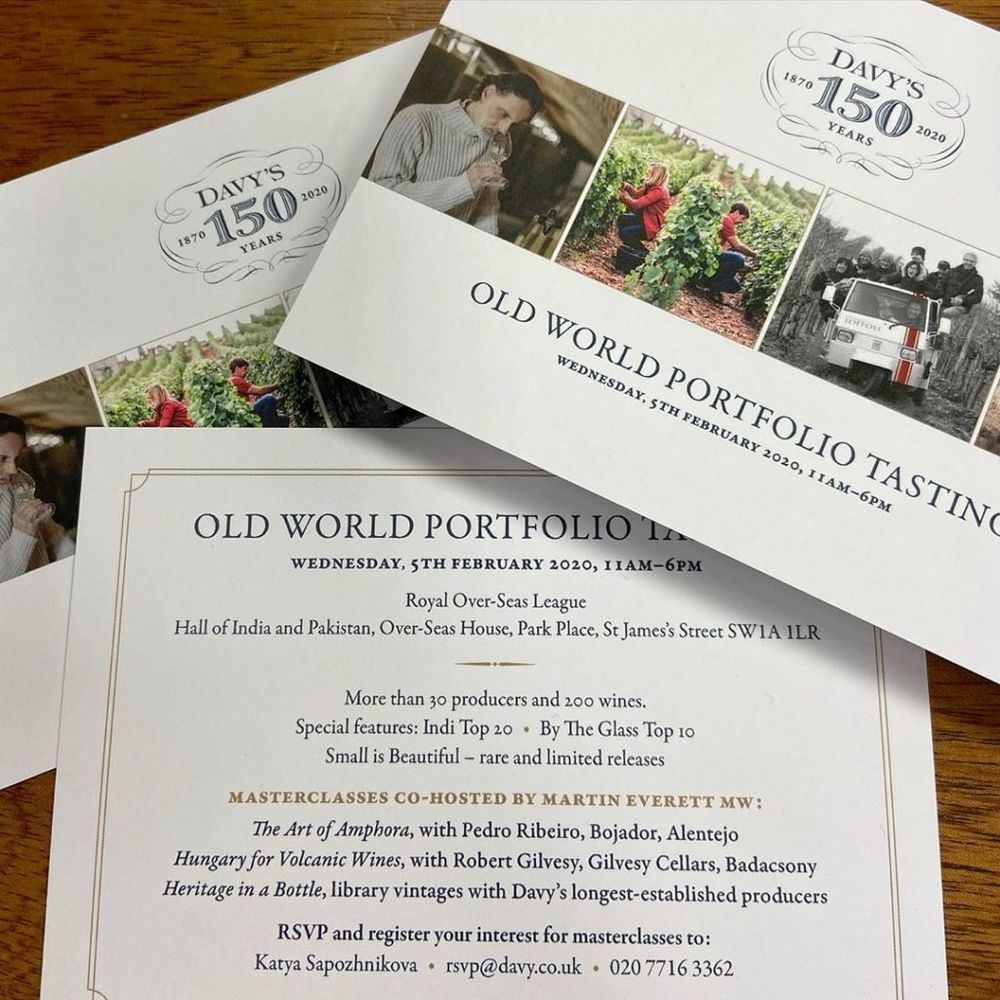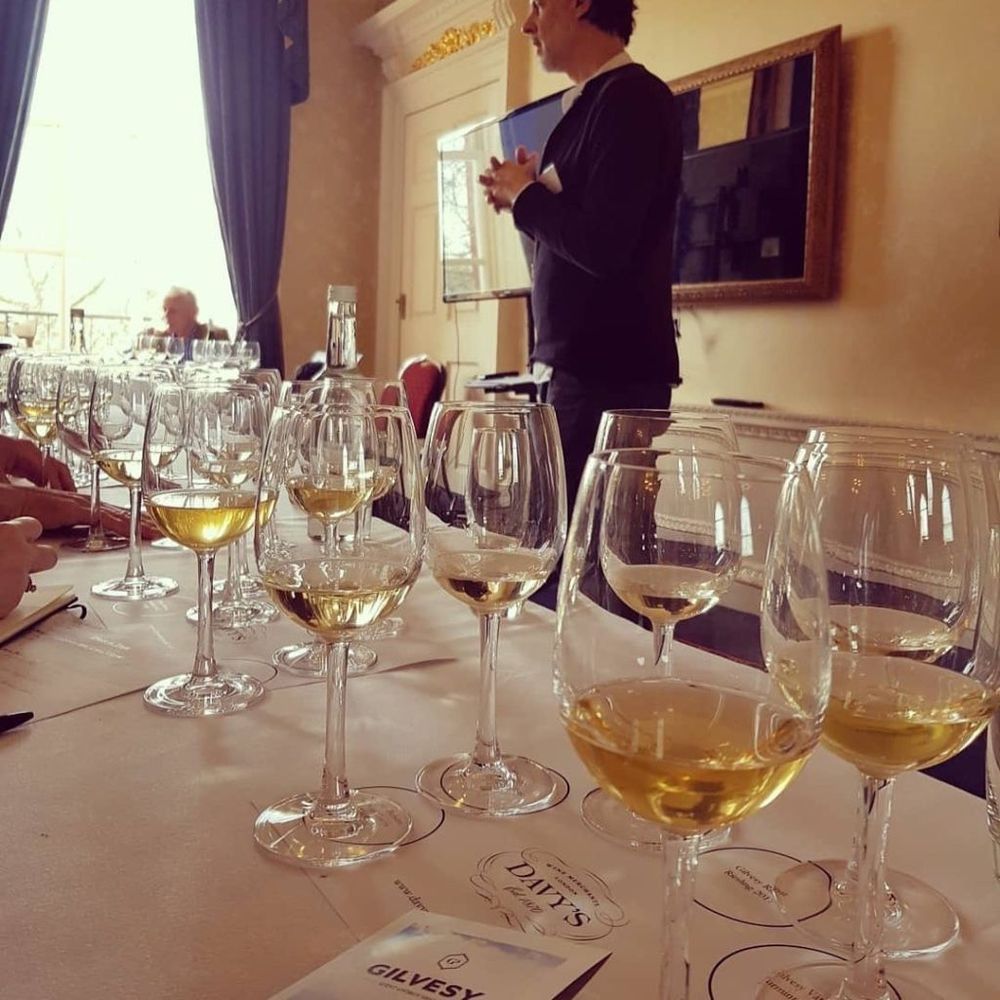Portugal’s Bojador, Hungary’s Gilvesy Cellars and Hoffman and Rathbone from East Sussex are producers that indicate how exciting the Davy’s portfolio is becoming, says Keay.
How do you commemorate a 150th birthday? By looking back on how things have changed since the British Empire was at its apogee? Or maybe cheering the huge improvement in relations between Paris and Berlin since the 1870 Franco-Prussian War? Or by considering the curious prospect of a new, colour-blind film version of David Copperfield released 150 years after Charles Dickens’ death?

James Davy, chairman of Davy’s Wine Merchants, chose an altogether tastier approach at last week’s ‘old world’ portfolio tasting, held to commemorate one and a half centuries of the eponymous London wine merchant. At a masterclass entitled ‘Heritage in a Bottle’, he unveiled six library wines from long-term suppliers which underscored just how long the merchant has been in business: a remarkable, still-fresh Champagne from Champagne Duménil produced in the year Margaret Thatcher first came to power (1979) a Domaine Tortochot Charmes Chambertin from the year the global financial crisis first hit (2007), a Gran Reserva Rioja from Bodegas de la Marquesa Valserrano Rioja from the year of 9/11 (2001) and a rich, wonderfully nutty and nuanced 2007 Riesling from Domaine Jean Becker, an Alsace producer that can trace its origins back to, well, even before Davy’s itself.
But the best was yet to come, in the extraordinary appearance of an 1870 Tawny Port from Quinta da Silveira – slightly cloudy, with some sediment, but remarkably smooth and flavourful – and James Davy’s own choice, an 1870 Verdelho Madeira from Blandy’s. It tasted…well, I won’t bother trying to describe it other than to say it was spectacular and demonstrated just how much history lies in those 150 year old cellars.
“With this tasting, I really wanted to honour our wonderful suppliers but also highlight how far we’ve come since we first started trading all those years ago,” Davy told me afterwards. He says the business is still very much evolving. Back in 1960, when his father opened the first Davy’s Wine Bar – “they were a first: the concept didn’t really exist before that because people didn’t really drink that much wine” – to 1992, when he took over, presiding over 45 wine bars by that point, to today, when the focus is much more on wholesale and retail, although the wine bars continue to do well.
“In many ways we’re the last man standing: Balls Brothers went into liquidation in 2010 (but have since re-emerged in slimmed-down form) whilst Corney & Barrow have pulled out of the wine bar business altogether. Times are tough but we’re pretty determined,” he says, adding that he manages all three parts of the business as one unit.
“Really, it’s the only way,” he says.
The strength in the Davy’s portfolio
The result is that the portfolio has to cover all the bases: City traders recovering from yet another Brexit-battered day on the exchanges, wealthy individuals bolstering their cellars and trendy restaurants looking for something different, which you can’t find anywhere else. Not easy to do, but Davy’s says it has 90% exclusivity on its wines, which is impressive, and it focuses on small, almost boutique producers which is another plus in my book.
OK, there are some wines here which are not exactly top drawer but the range is considerably more exciting than many, not least that of a highly respected importer whose tasting I attended recently, whose list was so unimaginative it might have been compiled back in the 1990s.
So who were the stars?
France and Spain are well represented, the latter with Bodegas Aragonesas from Campo de Borja, Bodegas Miguel Merino and Bodegas de la Marquesa Valserrano from Rioja Alta and Rioja Alavesa respectively, and from Navarra, Bodegas Ochoa (delicious Mil Gracias Graciano from 2013). From Germany there is SA Prum from the Mosel, from Portugal Quinta da Silveira from Douro and Quinta dos Capuchos from Lisbon, as well as the impressive Bojador from Alentejo, home to the award winning winemaker Pedro Ribeiro. From Dao, Somontes from Casa de Passaralla – made by winemaker Paulo Nunes, named as Portuguese Winemaker of the year in 2018 –and producer of some first class Encruzado, one of the wine’s world’s mega-trendy varieties right now.
From Italy, Davy’s have sourced good Nebbiolo from Azienda Agricola Pelassa in Piedmont; impressive, well balanced and well priced Brunello from La Togata, run entirely by the women of the Angel family and thus perfect for the woke generation. Hefty, good value Valpolicella Ripasso and Amarone (16%, so no mucking around) is available from the predominantly organic, family run Corte Cavedini, and from Chianti Classico, the Castelgreve 2015 is a good value Annata.

Robert Gilvesy is leading the charge for Hungarian wines outside of the well known Tokaj region at Givesy Cellars
Three producers who show which direction Davy’s is headed
But my focus at this tasting ended up being on three producers who both seem to illustrate the sorts of producer James Davy is keen to attract.
When I spoke to him a few years ago, he said he was planning to bring a Hungarian agency on board to meet the growing demand for wine from this country (which specialises in fresh whites, especially Furmint and Olasz Riesling). His choice, Gilvesy Cellars set up an expat Canadian around a decade ago – but who arrived in Hungary back in 1992 – is a good choice. His winery, which now produces some 100,000 bottles, is based in the volcanic Balatoni Borregio region, and the 17 hectares of organic vineyards he owns feature both volcanic and limestone soils. Robert Gilvesy says he sells 70% of his wines in Hungary and admits the UK market is difficult but having tasted the six wines he had on show, his Varadi Furmint 2017, grown on the shores of Lake Balaton, the Martinus Olaszrizling 2018 – grown in dolomitic limestone – and his great value Bohem Balatoni Cuvee 2018 should win over the doubters. Showing great precision and minerality, these are very appealing wines, illustrating again why Hungary seems to be everyone’s flavour of the month.
Hoffmann and Rathbone, East Sussex, UK. There’s boutique and then there’s mega-boutique and this winery – run by German winemaker Ulrich Hoffman and his wife, Birgit Rathbone – falls in the latter category. Celebrating its tenth birthday this year, they make just 16,500 bottles of delicious wine led by the balanced and characterful Classic Cuvee 2013 (60% PN, 30% CH, 10% PM) and their Bacchus 2018, one of the best expressions of the variety (it spends six months in oak). “We don’t want green apple flavours or over-high acidity, but instead aim for long-ageing so the wines can show themselves,” says Ulrich. Job done, I would say.
Bojador (Portugal). This Vidiguera winery, run by winemaker Pedro Ribeiro and his wife, focuses on native, near extinct varieties with their other USP being the use of Talha, which are traditional 1000 litre terracotta pots that (unlike in Georgia where the quevri are buried) rest above ground and are accessed by ladder. Grapes, skins, pips and stems all go into the Talha in layers, which give the resulting wines amazing complexity. The stand-out wines here are the Talha-aged Vinho de Talha Bojador Branco and Tinto (though it must be said that the cheaper, non-Talha wines are also very decent and good value, at around half the prices). Quite how impressive and distinct these wines are was evidenced during a masterclass when past vintages were shown; the whites – a blend generally of Perrum, Roupeiro, Rabo de Ovelha and Mantuedo – work particularly well, a dry firm backbone supporting the blend. The reds are rather more in transition; the 2016, which combines Trincadeira, Moreto and Tinta Grossa checks in at just 12.5% very low for this region, but also quite austere. The 2018 is more mainstream, aimed at easier drinkability, suggesting Bojador is aiming for a wider audience for these wines. Frankly they deserve it; this winery – focused on traditional methods and varieties and small volumes – has everything which makes Portuguese wine so exciting.
So as Davy’s 150thanniversary celebrations continue – including special discounts etc – its customers can rest assured it isn’t resting on its laurels. James Davy says the company is still evolving; judging by these wines, very much in the right direction.































